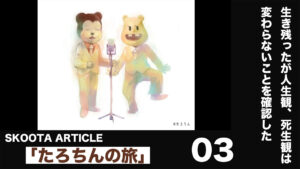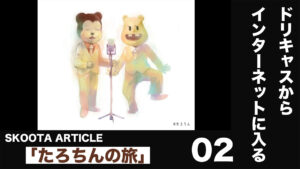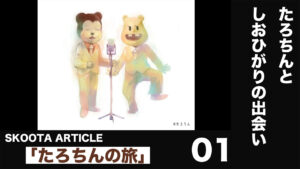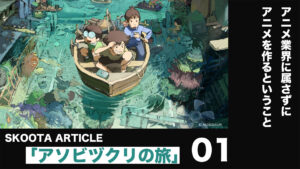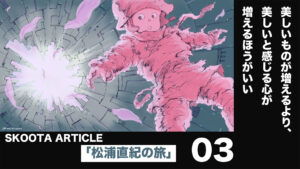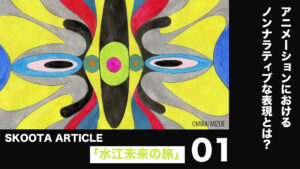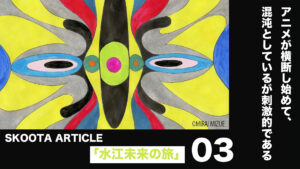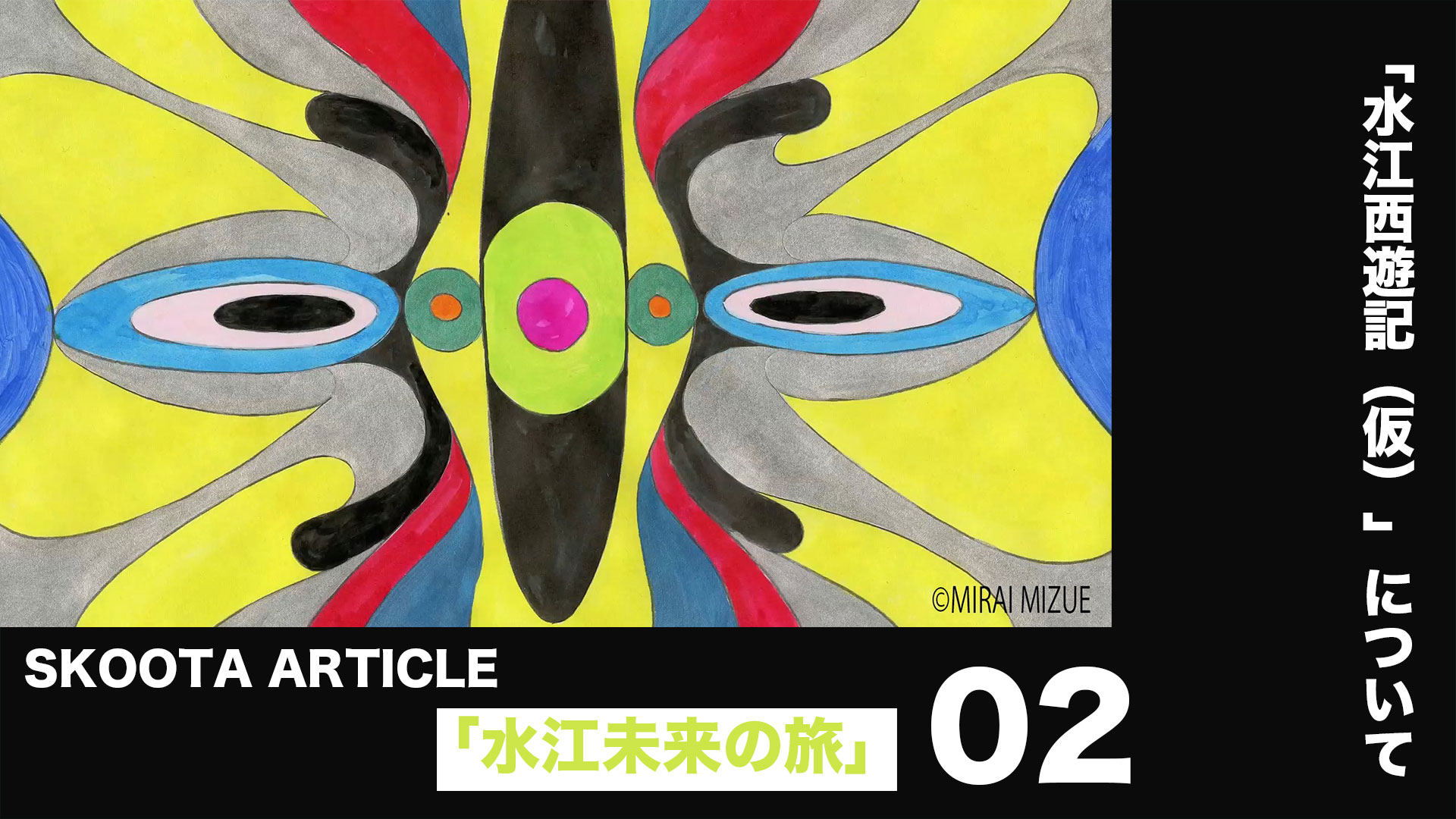
Guest, Personality
Guest: Mirai Mizue
Animation Artist
Born in Fukuoka, Japan in 1981, this animation artist creates non-narrative expressions using motifs such as “cells” and “geometric shapes”. He is known for their unique and captivating abstract animations and have worked on a wide range of projects including independent animation and music videos.
He has been nominated for all four major animation film festivals in the world (Annecy, Ottawa, Hiroshima, and Zagreb), and their masterpiece “MODERN No.2” premiered at the Venice International Film Festival and won the music award at the Annecy International Animation Film Festival.
“WONDER” premiered at the Berlin International Film Festival and won the CANAL+Creative Aid Award at the Annecy International Animation Film Festival. They are currently preparing to produce their first feature-length animation, “Mizue Saiyuki” (tentative title).
Personality: Yuuki Sakoda
After working for a telecommunications company and a comprehensive advertising agency, he started an anime planning and production company and produces music videos and films. In 2021, he moved to Kyoto and started working on promoting the entertainment industry in Kyoto. He is currently also working in the entertainment field of manga and audio. He is planning and producing audio dramas and webtoons. In addition, he serves as a producer and advisor for multiple entertainment companies.
Table of Contents
#01
- What is non-narrative expression in animation?
- My work was screened in the non-narrative section at a film festival.
- It’s not about having no “story” but rather not placing the “story” as the core of the work.
- I continue creating what I like without worrying about genres.
- Falling hurts, and soft things feel comfortable.
- From Jurassic Park and Terminator to the Lumière brothers.
- Movies are not just about stories but also about moments of experience.
- I love the unforgettable experiences scattered throughout films.
- On a summer day, playing a monster movie director game, mimicking an industrial complex in a vinyl pool.
- Memories of watching Return of the Jedi in the theater.
- Growing up with parents who loved movies.
- Standing in line to watch The Phantom Menace as a high school senior.
- A longing for the analog theater space.
- The shock of seeing T-1000.
- A desire to see the strange and unusual.
- From an ETERNITY interview.
- Creating something experimental and bizarre in a short duration.
- A ride-type experience to make a non-narrative piece that won’t let you sleep for 20 minutes.
- Realizing you were in a movie theater when the movie ends.
- The night of a bicycle sprint after watching ET.
#02
- Watching subjective visuals on a large flat screen becomes VR.
- The pleasure of visuals in “Spider-Verse.”
- The value of non-verbal expression.
- The ambiguity when communicating with words.
- Words from a woman in Germany who watched “WONDER.”
- Non-verbal expression may have the power to make viewers think spontaneously.
- Dislike for surveys.
- Talking about “Fraggle Rock.”
- About “Mizue Saiyuki (tentative).”
- The significance of doing Journey to the West now.
- How humans live and perceive the world.
#03
- About “License of Love.”
- Introducing many characters.
- The theme of expanding on life and death.
- Inspired by science books from Gakken that I read as a child.
- About the music by Twoth.
- Twoth also created music for Into Animation 8.
- The program of Into Animation 8.
- Animation is becoming more interesting.
- Anime is starting to cross boundaries, becoming chaotic but exciting.
My Experience with Trying Crowdfunding
Sakoda
To recap, I asked Mizue to interpret the term “non-narrative” and we had a conversation about it. From there, we talked about stories, and Mizue shared her childhood experience of her movie-loving parents taking her to see various films, including “Jurassic Park” and “Terminator,” which introduced her to computer graphics (CG). She found CG strange and different, but also pleasurable. This impression has continued to influence her work, including “ETERNITY,” which explores the release of the spirit from the body and the potential of abstract animation. I thought it would be interesting to hear more about the non-verbal value of the film, but I also think that the immersive, first-person, ride-like experience of a flat screen content in a movie theater is almost as good as VR. In fact, it may be a more stress-free way to experience VR-like sensations than wearing a VR headset.
I’ve been thinking for a while now that there might be a VR answer to this. Showing the ride type on a huge screen is probably the most stress-free way to do it. I really like Tokumaru Shugo’s music, and I thought it would be really pleasant to listen to his music at high volume here. I couldn’t go see it, but that’s what I thought.
In addition, I think there is some potential in abstract animation and the value of non-verbal communication. I would like to hear more about this later. What do you think?
Mirai Mizue
Well, there was talk within the team about creating a VR version of “ETERNITY”. We even applied for grants to make it happen, but unfortunately we didn’t receive any. After finishing the production of “ETERNITY”, we couldn’t start working on the VR version, but moving in first-person perspective while looking at a large screen can give you a VR-like sensation. For example, there used to be a “Back to the Future” attraction at USJ where a DeLorean was in a hemispherical screen, and even if you shake your head you’re still within the screen. If you try really hard, you can see the edges, but basically your entire field of view is covered. It’s like a real analog VR. When I first experienced VR, I thought it was like “Back to the Future: The Ride”, but I still had a desire to create something like that.
Recently, it’s that movie “Spider-Verse” that’s doing that kind of thing, right? It’s already like a flood of visuals, and the pleasure is incredible. In “Across the Spider-Verse,” the opening scene is an homage to Oscar Fishinger’s experimental animation. When they start playing the drums, it’s like, “Wow, really?” As someone who makes that kind of animation, it’s like, “Oh, they’re quoting Oscar Fishinger.”
So, there’s a scene where a large number of Spider-Men chase after the characters. And there was French director named Paul Grimault. He originally made a feature-length animated film called “The King and the Mockingbird,” but later remade it. In the original film, it was a man and a woman who were on the run, and there’s a famous scene where they run up a large staircase and a crowd of people try to catch them. It’s reminiscent of that. The filmmakers may not have intentionally referenced it or even remembered it, but I think scenes of large groups of people chasing someone are common enough in movies.
But I think people who are familiar with independent animation or European feature-length animation, or things like that, tend to incorporate those kinds of expressions, and it’s really exciting. At the same time, I get really excited because it feels like “Spider-Verse” is a movie that shows that there are many variations of this kind of movie that can be made by different people. It makes me feel like I want to try making a feature-length film myself. There’s really a lot of visual pleasure in recent movies.
Sakoda
Since the phrase “Let’s do our best with a long piece” came from Mizue-san, I feel like I could also talk about the long piece that I’m currently challenging myself with. I also thought it would be interesting to talk about “The Tyrant of the Thicket” and connect it with Miyazaki Hayao’s works, especially considering the season. There were also talks about the motifs of mandalas and such in the Metamorphose Animation and “ETERNITY,” so I think it’s really Buddhist in a sense, with its fundamental emptiness of thought. Like “Form is emptiness, emptiness is form” and “All things are impermanent,” for example. So I want to hear more about these motifs and such from Mizue-san. I feel like I have a backlog of things I want to ask her, haha. Anyway, for now, I would like to hear about “ETERNITY” and what Mizue-san thinks about the value of nonverbal communication.
Mirai Mizue
Well, you know, language is a really difficult thing. Without a common language, it’s hard to communicate with others. Even if you speak the same language, like English or Japanese, there can still be misunderstandings if there’s a big age gap or different life experiences. For example, I teach at a university and sometimes talk to students who are about half my age. They’ll use the word “昔” (mukashi) to refer to something that happened in middle school, which to them might be 5 years ago, but to me doesn’t seem like that long ago.
So when we talk about the past, present, or future, it can mean such different things depending on a person’s age, life experience, and perspective. Even if we’re speaking the same language, we might not really be communicating effectively unless we take the time to listen and understand each other. That’s why I think it’s important to approach communication from different angles and have multiple conversations with someone to really get to know them.
In a way, nonverbal forms of communication, like movies or animation, can be freeing from the constraints of language.
Mirai Mizue
I went to the Berlin Film Festival about 10 years ago. At that time, they screened a work called ‘WONDER’, which was an animation that lasted 6 minutes with constantly changing colors and shapes. PASCALS provided the music, which was very uplifting, and the animation continued to change. After watching the film, a female resident of Berlin who was a general audience member came up to me and gave me her impressions.
When people give me feedback on the works I have created so far, they usually comment on the timing of the music and visuals, or they say that there was a lot of movement and they were impressed visually. In other words, they usually give feedback on the visual and sensory aspects of the works. However, the feedback I received from this woman regarding ‘WONDER’ was different. What she said was, “I’ve been wearing only black and gray clothes and going to work every day, but I thought maybe I’ll start wearing red, yellow, and blue clothes occasionally and try to incorporate WONDER into my life.” She said that and went home.
I didn’t say that in the movie. I never said it, but people took it that way. I thought it was amazing and it made me realize that my work wasn’t great, but rather that abstract, non-narrative, non-verbal animation could make people think “I should start doing this tomorrow.” That’s the power that this kind of animation holds, and I witnessed it for the first time.
I had been making animations for over 10 years, but I never thought that my work could have that kind of impact. So, I felt that animation was really powerful and my purpose for creating it became much clearer. Through the experience of watching these visual works, people might come up with something new or incorporate something different from themselves. I don’t necessarily want to change people’s thoughts, but I do hope that these kinds of things can happen, and that’s why I make my works with the expectation that they will.
In that sense, I think that non-verbal works can make people spontaneously think or change their thoughts from within.
What is the value of nonverbal communication?
Sakoda
Oh, no. Based on the episode at the Berlin International Film Festival, I think the value of this nonverbal communication has been conveyed very clearly. We tend to think that language is the easiest way for mutual understanding because humans use language, but we are not good at using language. There are differences between interpretation and fact, and everyone naturally deviates from the premise, and words can be misunderstood. So, I think that creators often narrow the range of interpretations by using language due to the regulations that language brings.
This is my interpretation, but I feel that what Mizue creates is soft, and it is up to the viewer to receive and process that softness. I also felt that “WONDER” was very soft when I watched it. The music is really upbeat and exciting. Although not everyone may think so, I think that most people interpret something positive in their own way and take away something from the film, making it a work of nonverbal power.
For people who want to interpret something on their own, it’s a really encouraging technique, but on the other hand, there are quite a few people in the world who say they don’t want to be pushed and want things explained clearly in words. I think it has a lot to do with the attitude of the receiver, or the stage of life they are in. It’s like creating something together, non-verbally. I felt like it might be about creating something together with the customer and the creator.
Mirai Mizue
Well, let me see. When I listen to the current talk about surveys, I feel uncomfortable because I’m not good at them. I have a clear reason for it. When I fill out a survey, I worry that it might create new misunderstandings. So, I can’t easily give simple answers. For example, if someone asks me, “What’s your favorite food?” and I answer, “I like tamagoyaki (Japanese omelet),” then later, when I go out to eat with the people who conducted the survey, they might say, “So, Mizue, are you going to order tamagoyaki?” or “Please have some eggs,” and then eggs are served in front of me. When this happens, my liking for tamagoyaki becomes exaggerated, like “Well, I do like tamagoyaki, but it doesn’t mean I only eat eggs.”
The question “Who do you respect?” is a very difficult one. When I was in my teens, I used to write down Sakamoto Ryoma’s name or someone like that. But gradually, I couldn’t remember why I respected Sakamoto Ryoma. So, I stopped writing down his name and started writing “I don’t have anyone I respect.” But then, I worry that if I write that, people might think that I’m the kind of person who thinks they’re the most amazing. So, I end up not wanting to participate in surveys anymore.
I think the difficulty lies in the fact that we need to express our thoughts in words or language. That’s why, I think it’s a charm of visual works that we don’t necessarily have to express everything in words and just leave it to the imagination.
Sakoda
It’s interesting. As someone who intuitively feels limited by words, it feels like being forced to output the animation in words, even though I’m using animation as a form of expression. It’s like realizing “I’m limited” and feeling like “I can’t compensate for what I want to convey with words alone.” It’s understandable, isn’t it?
I would like to continue talking about this while also hearing a long story later on. Could you please introduce a song here? What do you think?
Mirai Mizue
Yes. This song is the theme song of “Fraggle Rock,” a television show that used Jim Henson’s Muppets, which I loved when I was a child. Please listen to the show’s theme song.
Story of Fraggle Rock
Mirai Mizue
I think it was a program I watched when I was in kindergarten, on NHK. It was a really interesting show about a man living with a dog in a certain house. That’s where the story takes place, and the old man and the dog live there. There are mouse holes in the walls, like mouse nests, and cameras go into them.
Then, inside, there’s a world where creatures called Fraggles, like mice, live. There are many different types of Fraggles there, and even smaller people who look like construction workers at a construction site. Those people are always building buildings that look like candy. But sometimes the Fraggles get rowdy and everyone starts making a fuss, so they end up breaking the things that the workers had worked so hard to build.
So there’s another world on the other side of that hole, and there are two different races there. One race works really hard, and the other sings and dances. If you go even further, you’ll go back to the outside world where there are characters in costumes called Fraggles that are controlled by puppets. But in this world, there are trolls who are actually people in suits trying to capture the Fraggles.
There are three different worlds nested within each other. There’s the world inside the old man’s house, the world of the Fraggles, and then the outer Troll world. It’s really fascinating to see the characters travel between these worlds and have new adventures in each episode. Going to another world that’s nested inside another world is really interesting. Yeah.
Sakoda
Hmm, it’s interesting. Although it may not be clear, I personally feel that recent movie trends are leaning towards multi-perspectives and multiple universes. Even if it’s just a normal shot of daily life or a linear one-hour shot, it’s amazing how different it can be when viewed from a different character’s perspective or point of view. I’ve recently felt that this format is being used more in movies.
So, in a way, works like “Fraggle Rock” have several worlds in the same place, and seeing them from a different perspective is a metaphor of some kind. I also thought about this while watching director Koreeda’s recent work “The Third Murder,” which uses a format where multiple viewpoints are used to tell one story. I think “One Cut of the Dead” is also like that. That’s what I thought.
Mirai Mizue
Yes, that’s right. “One Cut of the Dead” does that too, doesn’t it? It repeats Friday over and over again. Or rather, it’s more like a multiverse where they show the same day at school from different perspectives each time. All within the same time frame.
Sakoda
It’s very multiverse-like. “Everything Everywhere All At Once” is like that too. Well, I also think that Marvel is a different universe, but I feel like this movement is really coming. In order to tell the story, if we don’t speak in the third person, it’s probably already at the level where we don’t understand anymore. That’s what I really think.
Mirai Mizue
Well, yeah. Recently, shows like “The Flash” are like that too, right? Yes, the DC movie “The Flash” is a bit multiverse, isn’t it? Yeah. “ETERNITY” also has a bit of that, but the upcoming “Journey to the West” is also kind of multiverse-ish.
About Mizue Saiyuki
Sakoda
I was actually wondering about that too. To connect it with the discussion about “WONDER,” this film had its world premiere at the Berlin International Film Festival and won the “CANAL+ CREATIVE AID Award” at the Annecy International Animation Film Festival. I think that’s part of the reason why we’re talking about it now. Earlier, there was also mention of wanting to try making a feature-length film. Currently, there is a challenge to create a feature-length animation called “Mizue no Saiyuki (tentative),” which is now in production.
Mirai Mizue
Well, at present, we haven’t started the production yet. We are in the preliminary stage, and the story is being written by myself as the first step, such as the character drafts, and we are also making a 2-minute pilot film. We are preparing to raise funds. So, I have already written the story as a text, and it’s completed at this stage. Yes.
Sakoda
Is the plot and script of the full-length film adaptation ready to go now?
Mirai Mizue
Well, let’s see. But apparently if you do it as is, it will take about 3 hours and 40 minutes, so we’re wondering what to do. When you think about doing “Journey to the West” now, it’s basically a story about going to India, where the monk Tripitaka goes to get sutras. It’s Mahayana Buddhism, and even if you don’t understand the content, as long as you chant the sutras, it’s okay. Well, to put it simply.
Basically, the city where Tripitaka lives is already in such a state of decay, and in order to save the people there, they need the Mahayana Buddhist sutras. It’s a story about going to get them. India, or “Tenjiku” in Japanese, is what we now call India, and when the story was written, compared to the time it was written, India is not such a distant land. So when creating the story, they thought about how to depict Tenjiku as a place, and it became a science fiction setting.
Sakoda
It seems that the motif of Buddhism is also appearing here, and there are some elements of Buddhism in things that are naturally expressed. For example, sutras and mandalas may have such elements. I feel that Mizue understands and relates to such things.
Mirai Mizue
Well, there is a deep connection between “Journey to the West” and Buddhism, but in the story I wrote, there are not only Buddhist perspectives but also Christian aspects. I explore how religions, including Buddhism and Christianity, have been formed based on human thoughts and contemplate how individuals should live their lives.
I mentioned it’s like a new film by director Hayao Miyazaki, but I want to depict how to live and how to perceive the world. In that regard, elements of Buddhism, Christianity, and various other ideologies come into play. Ultimately, I think I have created a story that doesn’t provide a definitive answer in any of those perspectives.
Sakoda
I see. Earlier, you mentioned briefly that while there are such plots, they are depicted from various perspectives, so the length of the story has naturally become longer, is that right?
Mirai Mizue
Well, you see. The number of characters keeps increasing. In “Journey to the West,” there is Sanzo, a white horse that Sanzo rides, and Sun Wukong, Sha Wujing, and Zhu Bajie. Well, those are the members, but as we go towards the later part, in my “Mizue Saiyouki” that I am drawing, the number of characters keeps increasing like crazy. It becomes one group, one caravan, creating a new group, and there is a part where the story keeps amplifying as a result, and it ended up becoming like that.
Sakoda
It’s a conversation that tends to focus on specific topics such as expression methods and animation production techniques. What form will it take? For example, I really like Tempalay’s music video for “Abibanonnon,” which is a non-narrative experimental piece. I think it uses visual techniques that fit into the narrative or storytelling framework as much as possible. I’m curious about how “Mizue Saiyouki” will be depicted.
Mirai Mizue
Yeah, that’s right. I feel like I’m creating a lot of things while keeping in mind that eventually I want to make a feature film within the music videos. Within the music videos, there are elements that I’m experimenting with, which I want to incorporate into the feature film. In the past, I’ve used abstract animation as a means of expression, but now I’m thinking about how to incorporate abstract elements into the feature film that I have been working on. For example, there are scenes with Sun Wukong’s sorcery or transformations, and also depictions of changing landscapes.
The original story of “Journey to the West” spans 500 years in just one line. When reading the original “Journey to the West,” it’s amazing to see that Sun Wukong travels to India twice on his cloud.
Sakoda
Ah, he’s already gone ahead, hasn’t he?
Mirai Mizue
Yes, that’s right. So, if it’s just Goku, he can get there in no time, no problem. In the story, Sanzo is a very weak human being, so it takes a lot of time to protect him while they travel. And they have to go through various trials. That’s the story of “Journey to the West”. They have to overcome 108 hardships.
At the end of “Journey to the West”, there’s an interesting part where they receive sutras in India and on their way back, they have to cross a large river. I think they ride on a turtle or something. And it turns out they have only gone through 107 hardships. So the heavenly beings are like, “Oh, they’ve only gone through 107 hardships, they forgot one more.” And then the 108th hardship falls into the water from the turtle. The story ends with it falling into the last river, which is quite funny.
So, there’s definitely the charm of the original work. It has this sense of boundlessness and extraordinary ideas, which is what “Journey to the West” is all about. So, I thought it would be interesting to portray that using my own abstract interpretation. That’s why I chose this original work.

